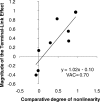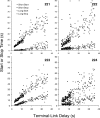Rapid acquisition of choice and timing and the provenance of the terminal-link effect
- PMID: 21451749
- PMCID: PMC2929086
- DOI: 10.1901/jeab.2010.94-209
Rapid acquisition of choice and timing and the provenance of the terminal-link effect
Abstract
Eight pigeons responded in a concurrent-chains procedure in which terminal-link schedules changed pseudorandomly across sessions. Pairs of terminal-link delays either summed to 15 s or to 45 s. Across sessions, the location of the shorter terminal link changed according to a pseudorandom binary sequence. On some terminal links, food was withheld to obtain start and stop times, measures of temporal control. Log initial-link response ratios stabilized within the first half of each session. Log response ratio was a monotonically-increasing but nonlinear function of programmed log terminal-link immediacy ratio. There was an effect of absolute terminal-link duration on log response ratio: For most subjects, preference for the relatively shorter terminal-link delay was stronger when absolute delays were long than when absolute delays were short. Polynomial regressions and model comparison showed that differences in degree of nonlinearity, not in sensitivity to log immediacy ratio, produced this effect. Temporal control of stop times was timescale invariant with scalar variability, but temporal control of start times was not consistent across subjects or terminal-link durations.
Keywords: concurrent chains; conditioned reinforcing value; key peck; pigeons; rapid acquisition procedure; temporal control; terminal-link effect.
Figures







Similar articles
-
Effects of unpredictable changes in initial-link duration on choice and timing.Behav Processes. 2009 Jun;81(2):227-32. doi: 10.1016/j.beproc.2008.12.024. Epub 2009 Jan 21. Behav Processes. 2009. PMID: 19429216
-
Rapid acquisition of choice and timing in pigeons.J Exp Psychol Anim Behav Process. 2007 Oct;33(4):392-408. doi: 10.1037/0097-7403.33.4.392. J Exp Psychol Anim Behav Process. 2007. PMID: 17924788
-
Environmental dynamics modulate covariation of choice and timing.Behav Processes. 2016 Mar;124:130-40. doi: 10.1016/j.beproc.2016.01.005. Epub 2016 Jan 21. Behav Processes. 2016. PMID: 26802787
-
Acquisition of choice in concurrent chains: Assessing the cumulative decision model.Behav Processes. 2016 May;126:82-93. doi: 10.1016/j.beproc.2016.03.011. Epub 2016 Mar 19. Behav Processes. 2016. PMID: 27005579 Review.
-
Reprint of "Acquisition of choice in concurrent chains: Assessing the cumulative decision model".Behav Processes. 2016 Jun;127:74-85. doi: 10.1016/j.beproc.2016.04.014. Epub 2016 May 4. Behav Processes. 2016. PMID: 27150444 Review.
Cited by
-
The influence of multiple temporal memories in the peak-interval procedure.Learn Behav. 2015 Jun;43(2):153-62. doi: 10.3758/s13420-015-0169-y. Learn Behav. 2015. PMID: 25731983 Free PMC article.
References
-
- Cheng K, Westwood R. Analysis of single trials in pigeons' timing performance. Journal of Experimental Psychology: Animal Behavior Processes. 1993;19:56–67.
-
- Christensen D.R, Grace R.C. Response allocation in a rapid-acquisition concurrent-chains procedure: Effects of overall terminal-link duration. Behavioural Processes. 2009;81:233–237. - PubMed
-
- Church R.M, Meck W.H, Gibbon J. Application of scalar timing theory to individual trials. Journal of Experimental Psychology: Animal Behavior Processes. 1994;20:135–155. - PubMed
MeSH terms
LinkOut - more resources
Full Text Sources

